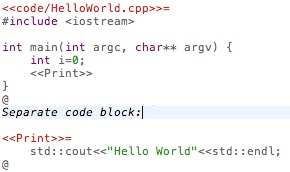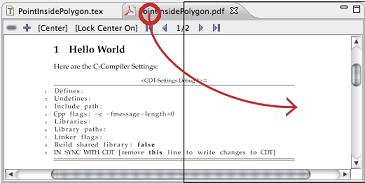First Steps
Leave a comment in our forum or write a mail
to get help: contact
To build the PDF, a TeX-Distribution is needed.
We recommend Tex Live, because it contains binaries for Synctex.
Synctex is used to synchronize the editor with the PDF.
http://tug.org/texlive/
To use the C++-features CDT and GCC are needed:
- CDT or
C/C++ Development Tooling is a plugin.
Install it via the eclipse install manager.
There exists also a special C++ version of eclipse:
http://www.eclipse.org/downloads/
- GCC is a compiler. Unix systems can install it
through the systems package manager. Under Mac OS X,
it‘s installed together with Xcode. Windows users may
be interested in the
wascana eclipse "plugin", or use
Mingw or Cygwin.
You than may create your first LEP Project, which can be
found in the group "Literate Eclipse Programming". After
choosing a name and location, a new editor is filled with
a sample document.
It contains a C++-Hello World application. With CDT and GCC
installed, you can compile and run the code from the "LEP"-menu
or via Project->Build and Run->Debug.

Every time you save the document, all the code is extracted
to files. The sample contains one file "HelloWorld.cpp" which
is saved in the subfolder "code".
This file includes the code block "Print", which is defined
afterwards, but can basically defined everywhere in the file.
By this, the sample shows how to create and link code blocks
and how to specify the location of files.

If not set otherwise in the
LEP Preferences, a pdf is
automatically created every time the document is saved. It will open
in a new eclipse tab. If available screen space allows it, the pdf tab
can be placed side by side to the lep editor. To do so, drag the pdf tab
to the border of the lep editor, e.g., drag it near the right scroll bar.
Eclipse gives a hint after the right spot is reached. To go from a line
in the text editor to the position in the pdf, use "Goto PDF" option from
the LEP-menu in the menu bar. Do a right-click on a word in the pdf to
switch to the according line in the text editor.

If your text grows, the outline view helps to navigate between the text
sections. It can be enabled from the menu bar under "Window->Show View".
It shows each (sub)(sub)section, the current on is marked in red and with
a small arrow behind it. Just click on an entry to switch to the editor line
of this heading.
Read on in the tutorials or write a mail
to get help: contact



